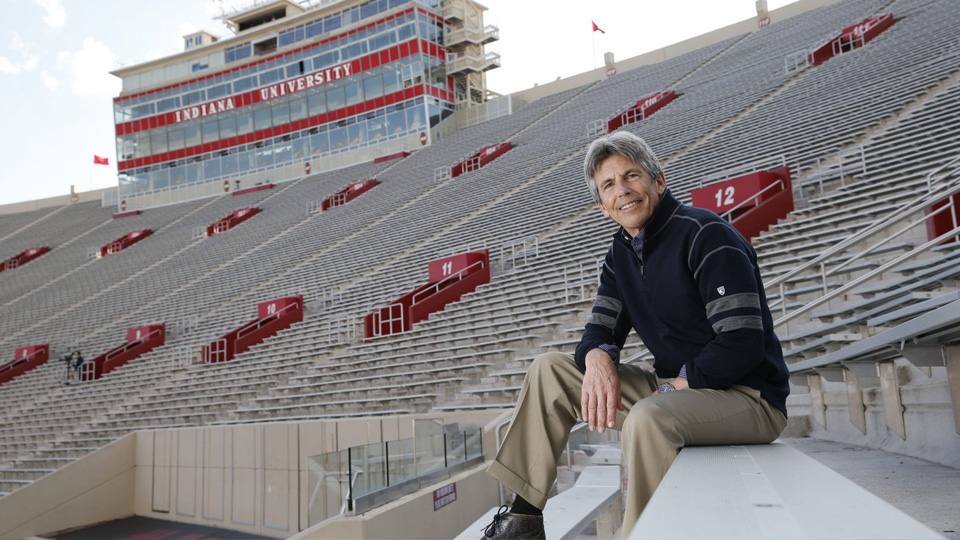NCAA, IU Play Major Role in Extension of ‘World’s Most Comprehensive Concussion Study’
Subscriber Benefit
As a subscriber you can listen to articles at work, in the car, or while you work out. Subscribe Now
The largest concussion and repetitive head impact study in history recently earned a 10-year extension to the tune of $42 million, and Indiana is continuing to help lead the charge. Recognizing that athletes and military cadets could answer some of the biggest questions surrounding head injuries, the NCAA, headquartered in Indianapolis, and Department of Defense (DOD) launched the historic study in 2014. The Indiana University School of Medicine (IUSM), also in Indianapolis, is the administrative and operations core for the study, meaning Hoosiers—both on the field and off—are playing a vital role in the study.
This next phase of the NCAA-U.S. DOD Concussion Assessment, Research and Education (CARE) Consortium will follow college athletes—including hundreds at IU Bloomington—and military personnel a decade after head injury. The military is awarding $25 million, the biggest share of additional funding, via the Medical Technology Enterprise Consortium (MTEC).
The NCAA is the second biggest funder, providing $10 million to help power scientists as they look at head injury through the longer-term lens. NCAA Chief Medical Officer Dr. Brian Hainline says the impact of the first eight years of the study can’t be overstated. Prior to CARE, more than 90% of concussion literature included only men and looked at just three sports: football, soccer and ice hockey. CARE includes male and female athletes in all 24 NCAA sports.
“Using football as just one example, through data we’ve obtained from the study, we’ve radically reshaped the preseason, and we’ve taken a completely new look at practice compared to competition,” says Hainline. “We understand from a numbers point of view, more concussions happen in practice, and from a relativity point of view, the preseason gets a larger share of those concussions. Through data like that, we’ve changed what the preseason looks like…and how those practices are divided up into full-contact versus not full-contact.
Among other measures, the NCAA has also developed a new concussion safety protocol as a result of the study. Although hundreds of IU athletes are playing a critical role in the study, IUSM Professor of Psychiatry Dr. Thomas McAllister says the extended study will also benefit the public broadly—even reaching down to youth sports and parents who ask, “How bad is it to get a concussion?” or “How bad is it for my child to be exposed to repetitive head impacts?”
As the first study in history to compare concussion to repetitive head impact exposure, CARE could answer some of the questions that loom largest by following the players 10 more years: is everybody affected the same way? If not, can scientists identify people who are at greater risk for having longer term problems?
“If you take two people and expose them to the same biomechanical blow—two football players hit the exact same way—are they each going to have the same outcome from that? And the answer is almost always no,” says McAllister, who leads CARE at IUSM. “So there seem to be individual differences in how people respond to this kind of brain impact. The questions are…are there genetic differences? Are there environmental differences that alter the course of recovery from that concussion? Many people in the field would say the answer is almost certainly yes, but this study gives us a chance to try to pinpoint some of those factors.”
McAllister says preliminary work in the field suggests certain genetic factors may make a person more or less likely to have a bad outcome after a concussion or brain injury. Using state-of-the-art neuroimaging tools, researchers might be able to uncover biomarkers in brain images that point to longer term effects. McAllister says the “underlying rationale for the study is to try to get some very practical answers” by following people over a longer period of time.
Hainline says the length of the study “in an ideal world” is 25 years—but is that enough? The field has already connected dementia and CTE to head injuries, but these conditions don’t appear until six to eight decades later.
“These long-term effects—and there’s still a lot of questions about what those effects are and whether everybody gets them—they don’t just pop up overnight,” says McAllister. “The brain isn’t completely normal for three decades, then you wake up one day with a full-blown case of dementia or CTE. The thinking here is there are probably indicators which start to manifest themselves earlier, if you’re using the right tools to look at that.”
Using highly sophisticated neurobehavioral measures, CARE could pinpoint some of those indicators by comparing two groups for 10 more years: a high-risk group regularly exposed to head impacts and a low-risk group never exposed. If indicators start to emerge in the brains of those in the high-risk group, “we’ll be pretty well-positioned…to pick up those early warning signs,” says McAllister.
The recent $42.65 million boost brings the total funding amount to more than $105 million to address some of the grand challenges in understanding how the brain responds to trauma. Noting that sport “has such great good for individuals and our society,” Hainline says “we desperately need this information.”
“Otherwise we’re going to be making decisions and maybe eliminating sport or exercise for unfound reasons,” says Hainline. “We have vacillated from many years ago, when concussion was not considered a serious injury in sports medicine, to then CTE being discussed; then the pendulum swung 180 degrees, saying concussion can cause serious long-term brain disease. And neither of those were based on good scientific evidence, so this study is helping all of society understand what concussion really is and what it isn’t.”
McAllister says following the athletes and cadets an additional ten years will provide parents, military leaders and the general public “some hard data and information to help make good decisions.”
